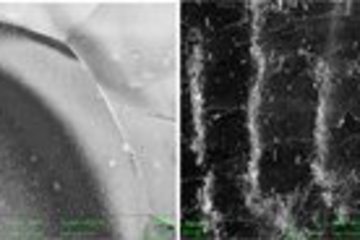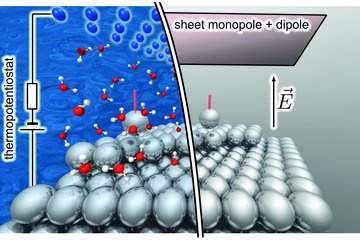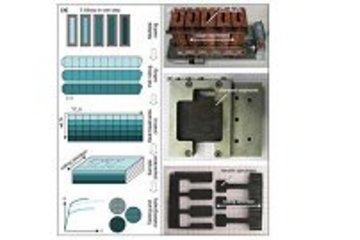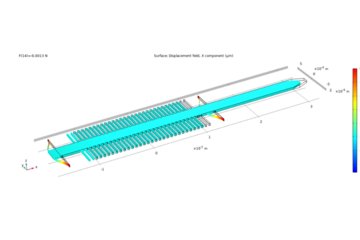All genres
1.
Journal Article
Correlative transmission Kikuchi diffraction and atom probe tomography study of Cu(In,Ga)Se2 grain boundaries. Progress in Photovoltaics: Research and Applications 26 (3), pp. 196 - 204 (2018)
2.
Journal Article
Molecular statics simulation of CdTe grain boundary structures and energetics using a bond-order potential. Modelling and Simulation in Materials Science and Engineering 26 (4), 045009 (2018)
3.
Journal Article
A correlative investigation of grain boundary crystallography and electronic properties in CdTe thin film solar cells. Solar Energy Materials and Solar Cells 166, pp. 108 - 120 (2017)
4.
Journal Article
3-Dimensional microstructural characterization of CdTe absorber layers from CdTe/CdS thin film solar cells. Solar Energy Materials and Solar Cells 151, pp. 66 - 80 (2016)
5.
Conference Paper
Electron backscatter diffraction (EBSD) and electron channelling contrast imaging (ECCI) for the study of thin film solar cells. In: Tagungsband des EFDS Workshops “Morphologie und Mikrostruktur Dünner Schichten und deren Beeinflussung” (Ed. Wetzig, K.). EFDS Workshop “Morphologie und Mikrostruktur Dünner Schichten und deren Beeinflussung”, Dresden, Germany, March 12, 2015. (2015)
6.
Talk
Correlative transmission Kikuchi diffraction and atom probe tomography analysis of grain boundaries in Cu(In,Ga) Se2 and CuInS2. E-MRS Spring Meeting 2018, Strasbourg, France (2018)
7.
Talk
Correlative transmission Kikuchi diffraction and atom probe tomography analysis of grain boundaries in Cu(In,Ga) Se2 and CuInS2 in thin film solar cells. APT&M 2018, NIST, Gaithersburg, MD, USA (2018)
8.
Talk
Using orientation microscopy to explore the correlation of materials properties and microstructures. 25th International conference on materials and technology, Portorož, Slovenia (2017)
9.
Talk
Recent Developments in the Analysis of Microstructures by 3D-EBSD. 12th European Congress for Stereology and Image Analysis, Kaiserslautern, Germany (2017)
10.
Talk
Correlative transmission EBSD-APT analysis of grain boundaries in CIGS and CZTS based thin-film solar cells. Euromat, Thessaloniki, Greece (2017)
11.
Talk
Recent Developments in the Analysis of Microstructures by 3D-EBSD. Symposium: 3D materials characterization at all length scales and its applications to iron and steel, Düsseldorf, Germany (2017)
12.
Talk
Correlative transmission EBSD-APT analysis of grain boundaries in Cu(In,Ga)Se2 and Cu2ZnSnSe4 based thin-film solar cells. Microscopy & Microanalysis, St. Louis, Missouri, USA (2017)
13.
Talk
Structure and Properties of Grain Boundaries in CdTe Solar Cells. E-MRS 2016 SPRING MEETING, Lille, France (2016)
14.
Talk
3-dimensionnal Microstructural Characterization of CdTe-based Solar Cells. Zentrum für Sonnenenergie- und Wasserstoff-Forschung Baden-Württemberg, Stuttgart, Germany (2015)
15.
Talk
Electron backscatter diffraction (EBSD) and electron channelling contrast imaging (ECCI) for the study of thin film solar cells. Workshop Morphologie und Mikrostruktur dünner Schichten, Dresden, Germany (2015)
16.
Talk
3-Dimensional Microstructural and Crystallographic Characterization of CdTe Absorber Layers from CdTe/CdS Solar Cells Grown in Substrate Configuration. E-MRS, European Materials Research Society Conference 2014
, Lille, France (2014)
17.
Talk
Advances in Analysis of 3D Orientation Data Sets Obtained by FIB-EBSD Tomography. 2nd International Congress on 3D Materials Science 2014, Annecy, France (2014)
18.
Talk
Challenges and Opportunities in the Analysis of 3D-EBSD datasets. European Congress for Stereology 2013, Kaiserslautern, Germany (2013)
19.
Talk
Challenges and Opportunities in the Analysis of 3D-EBSD datasets. Scandem 2013, Copenhagen, Demark (2013)
20.
Talk
Comprehensive, 5-parameter crystallographic grain boundary characterization and its application to thin-film CdTe solar cells. IDSC 2013, Düsseldorf, Germany (2013)











